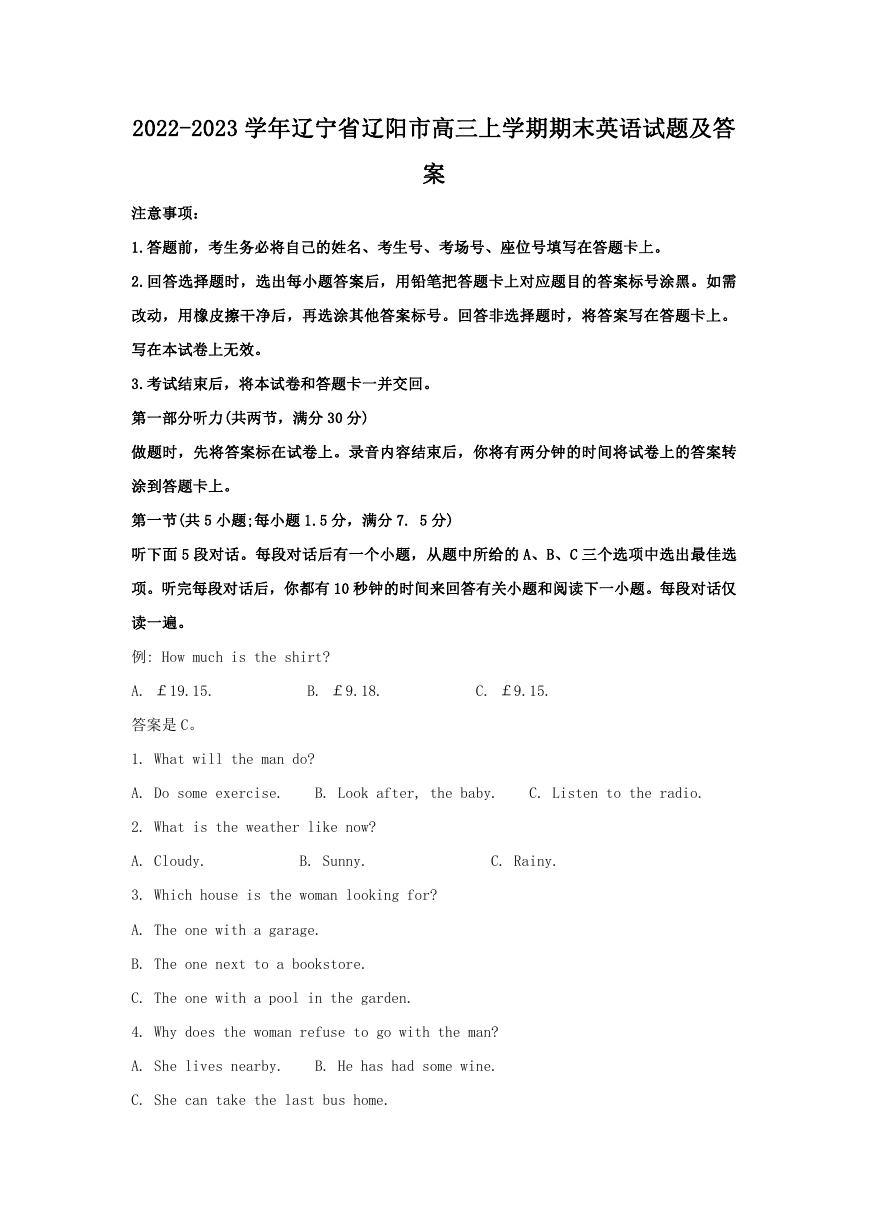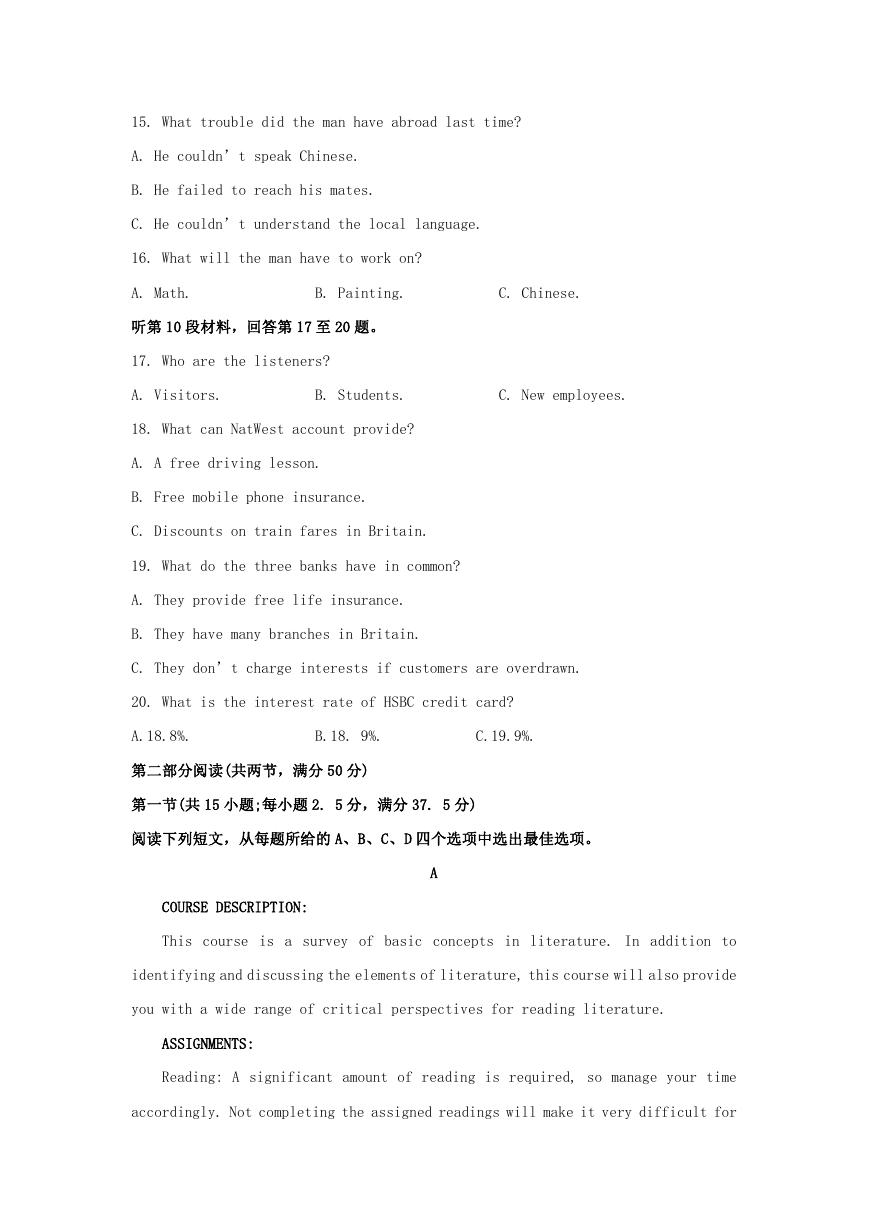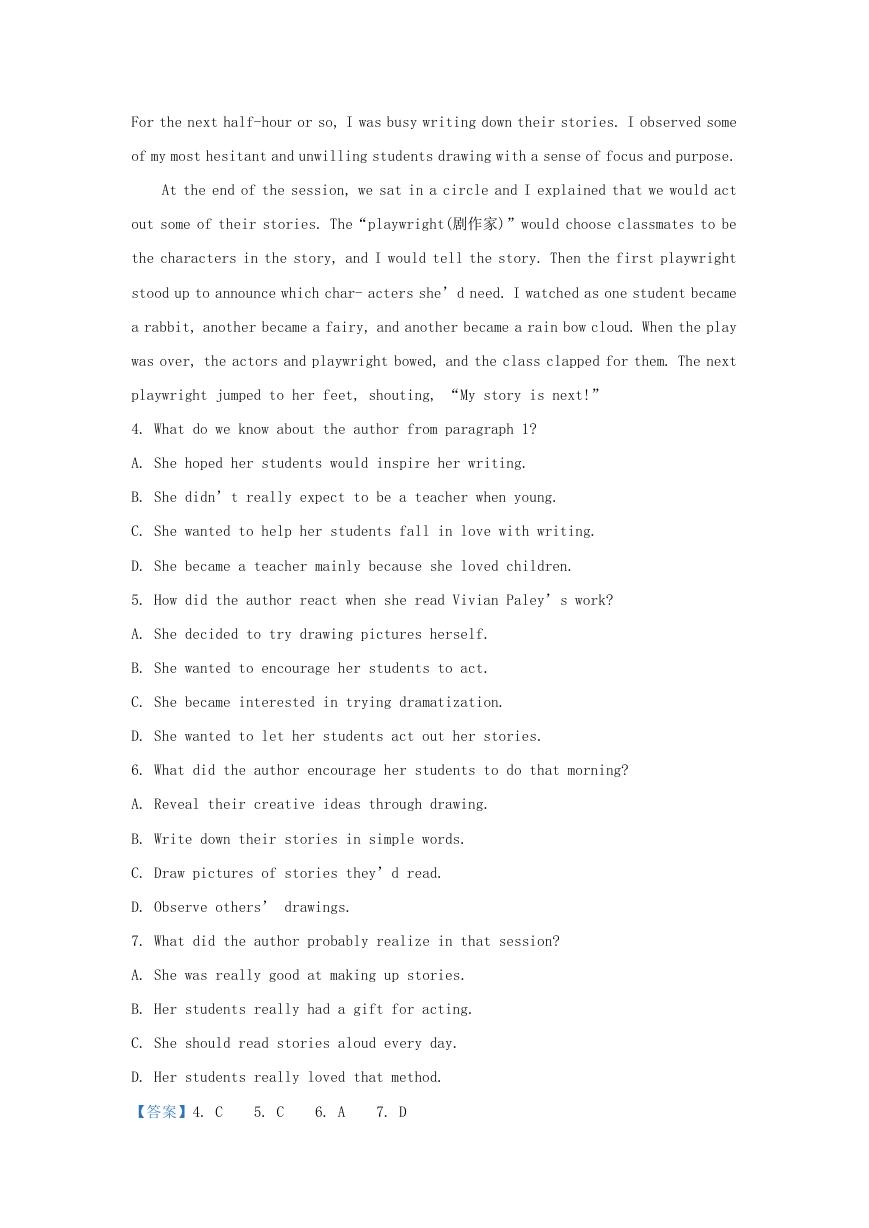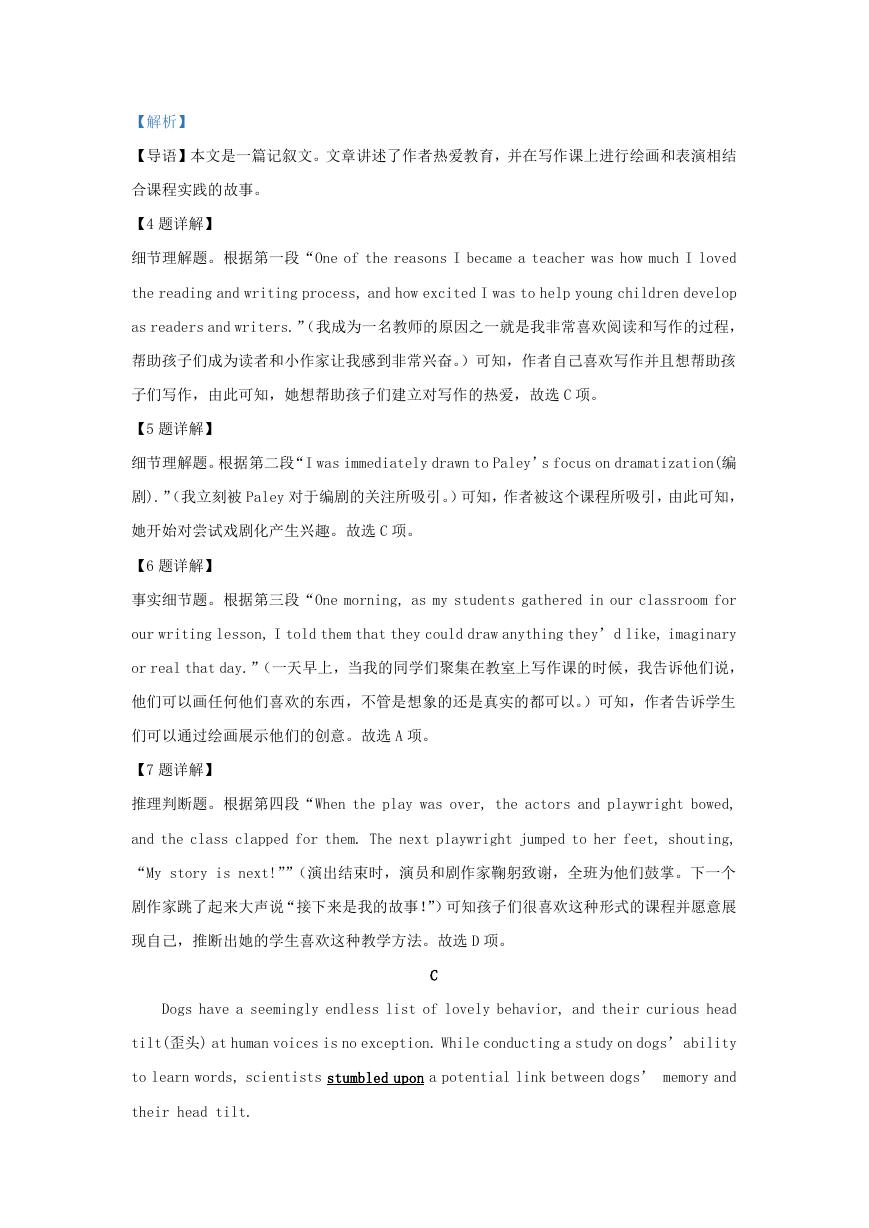2022-2023 学年辽宁省辽阳市高三上学期期末英语试题及答
注意事项:
案
1.答题前,考生务必将自己的姓名、考生号、考场号、座位号填写在答题卡上。
2.回答选择题时,选出每小题答案后,用铅笔把答题卡上对应题目的答案标号涂黑。如需
改动,用橡皮擦干净后,再选涂其他答案标号。回答非选择题时,将答案写在答题卡上。
写在本试卷上无效。
3.考试结束后,将本试卷和答题卡一并交回。
第一部分听力(共两节,满分 30 分)
做题时,先将答案标在试卷上。录音内容结束后,你将有两分钟的时间将试卷上的答案转
涂到答题卡上。
第一节(共 5 小题;每小题 1.5 分,满分 7. 5 分)
听下面 5 段对话。每段对话后有一个小题,从题中所给的 A、B、C 三个选项中选出最佳选
项。听完每段对话后,你都有 10 秒钟的时间来回答有关小题和阅读下一小题。每段对话仅
读一遍。
例: How much is the shirt?
A. £19.15.
B. £9.18.
C. £9.15.
答案是 C。
1. What will the man do?
A. Do some exercise.
B. Look after, the baby.
C. Listen to the radio.
2. What is the weather like now?
A. Cloudy.
B. Sunny.
C. Rainy.
3. Which house is the woman looking for?
A. The one with a garage.
B. The one next to a bookstore.
C. The one with a pool in the garden.
4. Why does the woman refuse to go with the man?
A. She lives nearby.
B. He has had some wine.
C. She can take the last bus home.
�
5. Where are the speakers?
A. In a library.
B. In a supermarket.
C. In a cinema.
第二节(共 15 小题;每小题 1.5 分,满分 22. 5 分)
听下面 5 段对话或独白。每段对话或独白后有几个小题,从题中所给的 A、B、C 三个选项
中选出最佳选项。听每段对话或独白前,你将有时间阅读各个小题,每小题 5 秒钟;听完后,
各小题将给出 5 秒钟的作答时间。每段对话或独白读两遍。
听第 6 段材料,回答第 6、7 题。
6. What is probably the woman?
A. A teacher.
B. A manager.
C. A director.
7. What is the relationship between the speakers?
A. Classmates.
B. Colleagues.
C. Boss and employee.
听第 7 段材料,回答第 8、9 题。
8. Where does Mike come from?
A. Britain.
B. Canada.
C. New Zealand.
9. What does the woman think of Mike?
A. He is helpful.
B. He is humorous.
C. He is strong.
听第 8 段材料,回答第 10 至 12 题。
10. What color is the man’s shirt now?
A. Bright pink.
B. Bright red.
C. Light pink.
11. How did the man wash his shirt?
A. He had it dry-cleaned.
B. He washed it by hand.
C. He washed it in the washing machine.
12. What will the man probably do in the end?
A. Return his shirt.
B. Keep his shirt.
C. Change his shirt.
听第 9 段材料,回答第 13 至 16 题。
13. What is the man going to do this summer holiday?
A. Travel abroad.
B. Go camping.
C. Visit his aunt.
14. Where will the woman spend her summer holiday?
A. In China.
B. In Spain.
C. In Australia.
�
15. What trouble did the man have abroad last time?
A. He couldn’t speak Chinese.
B. He failed to reach his mates.
C. He couldn’t understand the local language.
16. What will the man have to work on?
A. Math.
B. Painting.
C. Chinese.
听第 10 段材料,回答第 17 至 20 题。
17. Who are the listeners?
A. Visitors.
B. Students.
C. New employees.
18. What can NatWest account provide?
A. A free driving lesson.
B. Free mobile phone insurance.
C. Discounts on train fares in Britain.
19. What do the three banks have in common?
A. They provide free life insurance.
B. They have many branches in Britain.
C. They don’t charge interests if customers are overdrawn.
20. What is the interest rate of HSBC credit card?
A.18.8%.
B.18. 9%.
C.19.9%.
第二部分阅读(共两节,满分 50 分)
第一节(共 15 小题;每小题 2. 5 分,满分 37. 5 分)
阅读下列短文,从每题所给的 A、B、C、D 四个选项中选出最佳选项。
COURSE DESCRIPTION:
A
This course is a survey of basic concepts in literature. In addition to
identifying and discussing the elements of literature, this course will also provide
you with a wide range of critical perspectives for reading literature.
ASSIGNMENTS:
Reading: A significant amount of reading is required, so manage your time
accordingly. Not completing the assigned readings will make it very difficult for
�
you to successfully complete this course.
Quizzes (30%): Reading quizzes will be given once a week throughout the semester,
to test completion and comprehension of assigned readings.
Reflection Essays (60%): You will complete four short reflection essays. You
must turn in paper copies of your papers.
Attendance Policy (10%): Every absence will affect your participation grade.
If you miss more than four classes and any of these absences are unexcused, you
receive an F for the participation section of your grade.
LATE ASSIGNMENTS:
Because I grade on a point system, it is better to turn in an assignment late
than not at all, However, I will not accept a paper that is more than a week late
without a documented and reasonable excuse. Not to turn in an assignment will result
in a zero.
INTEGRITY:
If a faculty (系;院) member discovers that a student has committed an academic
integrity violation (违背), in addition to reporting the incident, I reserve the
right to give the plagiarized (抄袭) paper an automatic F or a student who has
plagiarized an automatic F in the course if the plagiarism is clearly intentional.
1. What will the course equip students with?
A. Time management.
C. Academic gift.
B. Reading speed.
D. Critical insight.
2. Which one is the course’s rule?
A. The students will be tested per week on required readings.
B. The students will get a zero if failing to show up in class.
C. The students will fail if submitting their assignments late.
D. The students will be asked to leave if found plagiarizing.
3. What is the text most likely to be?
A. A study schedule.
B. A course introduction.
C. An academic article.
D. An exam paper.
【答案】1. D
2. A
3. B
�
【解析】
【导语】这是一篇应用文。文章主要介绍了一个文学课程的详细情况,包括作业,考试等。
【1 题详解】
细节理解题。根据第一段最后一句话“In addition to identifying and discussing the
elements of literature, this course will also provide you with a wide range of
critical perspectives for reading literature.(除了识别和讨论文学的元素,本课程还
将为您提供阅读文学的广泛批判性视角)”可知,该课程能够让学生具备批判性的视角。故
选 D。
【2 题详解】
细节理解题。根据 ASSIGNMENTS 大标题下的第二段“Quizzes (30%): Reading quizzes will
be given once a week throughout the semester, to test completion and comprehension
of assigned readings.(测验(30%):整个学期每周进行一次阅读测验,以测试指定阅读的
完成程度和理解程度)”可知,学生们每周都会接受要求的阅读测试。故选 A。
【3 题详解】
推理判断题。根据第一段第一句“This course is a survey of basic concepts in
literature.(本课程是对文学基本概念的概述)”以及全文可推知,这篇文章介绍了一个文
学课程的详细情况,包括作业,考试等。故选 B。
B
One of the reasons I became a teacher was how much I loved the reading and writing
process, and how excited I was to help young children develop as readers and writers.
I had visions of a class full of busy writers, all with the same sense of excitement
I’ve always had about writing and sharing stories.
One day, I discovered the work of Vivian Paley, who developed a storytelling
curriculum for young children that involves writing down the contents of students’
drawings and having their classmates act out these stories. I was immediately drawn
to Paley’s focus on dramatization(编剧).
One morning, as my students gathered in our classroom for our writing lesson,
I told them that they could draw anything they’d like, imaginary or real that day.
They discussed with one another what they liked to draw and shared some of these
ideas out loud, which helped inspire those who weren’t ready with their own ideas.
�
For the next half-hour or so, I was busy writing down their stories. I observed some
of my most hesitant and unwilling students drawing with a sense of focus and purpose.
At the end of the session, we sat in a circle and I explained that we would act
out some of their stories. The“playwright(剧作家)”would choose classmates to be
the characters in the story, and I would tell the story. Then the first playwright
stood up to announce which char- acters she’d need. I watched as one student became
a rabbit, another became a fairy, and another became a rain bow cloud. When the play
was over, the actors and playwright bowed, and the class clapped for them. The next
playwright jumped to her feet, shouting, “My story is next!”
4. What do we know about the author from paragraph 1?
A. She hoped her students would inspire her writing.
B. She didn’t really expect to be a teacher when young.
C. She wanted to help her students fall in love with writing.
D. She became a teacher mainly because she loved children.
5. How did the author react when she read Vivian Paley’s work?
A. She decided to try drawing pictures herself.
B. She wanted to encourage her students to act.
C. She became interested in trying dramatization.
D. She wanted to let her students act out her stories.
6. What did the author encourage her students to do that morning?
A. Reveal their creative ideas through drawing.
B. Write down their stories in simple words.
C. Draw pictures of stories they’d read.
D. Observe others’ drawings.
7. What did the author probably realize in that session?
A. She was really good at making up stories.
B. Her students really had a gift for acting.
C. She should read stories aloud every day.
D. Her students really loved that method.
【答案】4. C
5. C
6. A
7. D
�
【解析】
【导语】本文是一篇记叙文。文章讲述了作者热爱教育,并在写作课上进行绘画和表演相结
合课程实践的故事。
【4 题详解】
细节理解题。根据第一段“One of the reasons I became a teacher was how much I loved
the reading and writing process, and how excited I was to help young children develop
as readers and writers.”(我成为一名教师的原因之一就是我非常喜欢阅读和写作的过程,
帮助孩子们成为读者和小作家让我感到非常兴奋。)可知,作者自己喜欢写作并且想帮助孩
子们写作,由此可知,她想帮助孩子们建立对写作的热爱,故选 C 项。
【5 题详解】
细节理解题。根据第二段“I was immediately drawn to Paley’s focus on dramatization(编
剧).”(我立刻被 Paley 对于编剧的关注所吸引。)可知,作者被这个课程所吸引,由此可知,
她开始对尝试戏剧化产生兴趣。故选 C 项。
【6 题详解】
事实细节题。根据第三段“One morning, as my students gathered in our classroom for
our writing lesson, I told them that they could draw anything they’d like, imaginary
or real that day.”(一天早上,当我的同学们聚集在教室上写作课的时候,我告诉他们说,
他们可以画任何他们喜欢的东西,不管是想象的还是真实的都可以。)可知,作者告诉学生
们可以通过绘画展示他们的创意。故选 A 项。
【7 题详解】
推理判断题。根据第四段“When the play was over, the actors and playwright bowed,
and the class clapped for them. The next playwright jumped to her feet, shouting,
“My story is next!””(演出结束时,演员和剧作家鞠躬致谢,全班为他们鼓掌。下一个
剧作家跳了起来大声说“接下来是我的故事!”)可知孩子们很喜欢这种形式的课程并愿意展
现自己,推断出她的学生喜欢这种教学方法。故选 D 项。
C
Dogs have a seemingly endless list of lovely behavior, and their curious head
tilt(歪头) at human voices is no exception. While conducting a study on dogs’ability
to learn words, scientists stumbled upon a potential link between dogs’ memory and
their head tilt.
�
In the study, researchers looked at the head tilt patterns of both“gifted”
and “typical” dogs. Owners ordered their dogs to fetch a specific toy from another
room. While most dogs struggled to memorize the name of just two toys, the seven
“gifted” dogs-all of which were border collies(牧羊犬)could remember at least ten
different toy names they'd been taught by researchers.
The team found that dogs that were particularly good at toy recall tilted their
heads more often when hearing a command than dogs which weren’t as skilled. When
they compared the dogs’ responses to a command from their owners, gifted dogs tilted
their heads 43 percent of the time, while typical dogs did so just 2 percent of the
time. It’s possible, scientists concluded, that the dogs’ head tilt may be a sign
of paying attention or even matching a name to a visual image in their heads.
Researchers also discovered that dogs usually tilted their heads in the same
direction regardless of where the owner was standing. The so-called “right-tilters
“ and “left-tilters” may be a matter of individual preference. “The next step
is to ask more questions to know what the head tilt really means,“says the researcher
Monique Udell. “ Can we use head tilting to predict word-learning ability, or
attention, or memory?””
The researchers agree that the study is still in the early stages. For now, dog
owners can take comfort in knowing that their dogs’ head tilt maybe a lovely attempt
to better understand them.
8. Which of the following best explains “stumbled upon“ underlined in paragraph
1?
A. Broke by accident.
B. Discovered unexpectedly.
C. Imagined without reason.
D. Investigated secretly.
9. What were the dogs asked to do in the study?
A. Find out the hidden toys.
B. Find the name of the toys.
C. Separate the different toys.
D. Go to get the toys mentioned.
10. What did the researchers find out about the gifted dogs hearing commands?
�
















 2023年江西萍乡中考道德与法治真题及答案.doc
2023年江西萍乡中考道德与法治真题及答案.doc 2012年重庆南川中考生物真题及答案.doc
2012年重庆南川中考生物真题及答案.doc 2013年江西师范大学地理学综合及文艺理论基础考研真题.doc
2013年江西师范大学地理学综合及文艺理论基础考研真题.doc 2020年四川甘孜小升初语文真题及答案I卷.doc
2020年四川甘孜小升初语文真题及答案I卷.doc 2020年注册岩土工程师专业基础考试真题及答案.doc
2020年注册岩土工程师专业基础考试真题及答案.doc 2023-2024学年福建省厦门市九年级上学期数学月考试题及答案.doc
2023-2024学年福建省厦门市九年级上学期数学月考试题及答案.doc 2021-2022学年辽宁省沈阳市大东区九年级上学期语文期末试题及答案.doc
2021-2022学年辽宁省沈阳市大东区九年级上学期语文期末试题及答案.doc 2022-2023学年北京东城区初三第一学期物理期末试卷及答案.doc
2022-2023学年北京东城区初三第一学期物理期末试卷及答案.doc 2018上半年江西教师资格初中地理学科知识与教学能力真题及答案.doc
2018上半年江西教师资格初中地理学科知识与教学能力真题及答案.doc 2012年河北国家公务员申论考试真题及答案-省级.doc
2012年河北国家公务员申论考试真题及答案-省级.doc 2020-2021学年江苏省扬州市江都区邵樊片九年级上学期数学第一次质量检测试题及答案.doc
2020-2021学年江苏省扬州市江都区邵樊片九年级上学期数学第一次质量检测试题及答案.doc 2022下半年黑龙江教师资格证中学综合素质真题及答案.doc
2022下半年黑龙江教师资格证中学综合素质真题及答案.doc